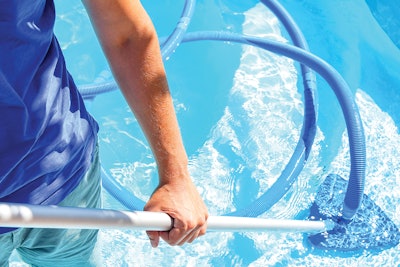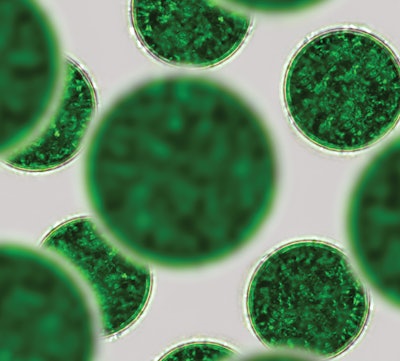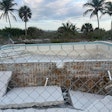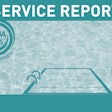
With this being the June issue, I figured it was a good time to update you on my research. First, a little background.
Some of you will recall that in 2018, in the absence of any solid documentation on swimming pool black algae available to any of us, I decided to research the problem on my own in one of those "hold my beer" moments. How hard could it be, right?
I started collecting field specimens of black algae from a public swimming pool in Gainsville, which I discovered were made up of not one, but several genera of cyanobacteria (blue/green algae) in an intertwined colony. Further, as I took samples from other pools in the area, I realized that the constituents of swimming pool "black algae" can differ significantly within a distance as small as 100 miles.
As often happens in research, you find yourself searching for one thing, and in the process, you discover something else entirely, something surprising. In the process of looking for something to kill black algae, I stumbled on a means of lowering cyanuric acid (CYA). If perfected, this would save a lot of water, as pools would not need to drain and refill to lower CYA levels, which wastes a lot of water everywhere, but is a particular problem in areas of drought.
I first announced some success in this effort at the "Great Cyanuric Acid Debate," hosted by AQUA Magazine at the 2019 International PSP Expo held in New Orleans.
This announcement sparked two things to occur. First, I found tremendous support from pool service professionals from coast to coast in conducting field trials of my alum-CYA removal method. Second, I encountered a considerable backlash from some manufacturers and a few within the pool and spa industry's scientific community.
The initial results from the field trials were promising; we saw 40 to 50% drops in CYA levels. These results were coming from pool professionals who volunteered to participate in trials and data collection, but after that breakthrough, everything stalled. None of the chemical manufacturers within the industry seemed interested in building on that research, so I began to look at universities and private research facilities — no luck there, either.
The reality I found is that to most organizations, the swimming pool industry is just small potatoes. I was informed that something benefiting pools alone was not worth the effort it would take. Those that did show an interest lacked the equipment necessary to identify the metal complexation (aluminum-cyanurate) I was theorizing to occur.
Despite the lack of interest from academia and industry, over the next few seasons, pool service professionals voluntarily investigating the method reported encouraging results in their alum-CYA removal trials.
 The single cells of cyanobacteria (in this case, green algae) under a microscope.
The single cells of cyanobacteria (in this case, green algae) under a microscope.
CONFIRMATION
Meanwhile, Que Hales and Kim Skinner of onBalance (a research, education and consulting firm in the fields of swimming pool water chemistry interactions) out of Tucson, Ariz., had taken an interest in the method. With laboratory and field test abilities, the team looked to duplicate the results I and others — members of the Talking Pools, 14 PSI, and Aquatic Artisan Facebook groups — had achieved in field trials (a nod to John Poma who took on the lion's share of field trials).
Although we don't have an explanation of what is happening on a molecular level, Que Halesdid announce — in his session on advanced water chemistry at the Western Pool & Spa Show in late March of 2023 — confirmation that the alum-CYA removal method did indeed work; however, more field and lab data would need to be collected to determine precisely what reactions were occurring, to what extent, and which complexes were forming.
Que's CYA reductions were not as significant as those we had been experiencing, but Que did share that his test pools had high copper levels. We had seen that same effect in our data from the field — the results were less significant in water that contained a certain level of copper. Also, Que shared that he had been conducting his trials with water colder than we had recommended.
He said that arrangements have already been made for further analysis in a laboratory with cutting-edge equipment for compositional analysis.
UNEXPECTED RESULT
Throughout this period of investigation of the CYA-alum reaction, another pattern began to emerge. I began to receive interesting reports from the field that I had not expected, such as these two from seasoned maintenance professionals: but I could see how aluminum could work at a much higher dose. (8.33 pounds of aluminum sulfate per 10,000 gallons of water will provide 100 ppm of aluminum sulfate. However, aluminum sulfate is only 15.8% aluminum; therefore, this dose adds only 15.8 ppm of aluminum. Compare that to the maximum permitted copper level in a swimming pool — 1 ppm.)
I announced these results at the AQUA LIVE trade show in Charlotte during my "Truth About Black Algae" session in the fall of last year. Since being made aware of the instant eradication of the black algae plague from several pros, I suggested others try the aluminum sulfate dose as a remedy. Unfortunately, the results were inconsistent, and success was only about four in 10.
ONWARD
I proceeded with my own investigation. I wanted to test this for myself to monitor the reaction. I put different cyanobacteria cells on slides under a microscope and exposed them to different concentrations of aluminum sulfate. I watched and watched and watched. I was fully expecting to witness the disintegration of the algae cells. Sadly, that did not happen. I had disproven my theory.
The black algae wasn't dying, but four out of 10 pool pros had observed it coming loose and falling off the walls. Why?
That's what I'm trying to figure out now. I have shifted gears to focus on what makes it stick and what can make it come loose, so you can just vacuum it up.
And that is where we're at. My investigation continues...
This article first appeared in the June 2023 issue of AQUA Magazine — the top resource for retailers, builders and service pros in the pool and spa industry. Subscriptions to the print magazine are free to all industry professionals. Click here to subscribe.












































